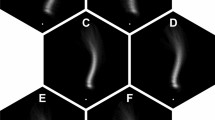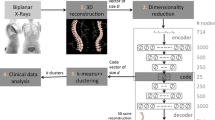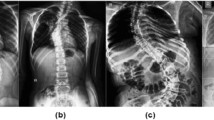Abstract
Objective
This article describes a computer-based method for the classification of spine scoliosis severity. This is a first step toward an effective computerized tool to assist general practitioners diagnose spine scoliosis. The method progresses away from Cobb angles toward pattern and magnitude categorization based upon 3D configurations.
Materials and methods
The purpose is to classify spine shapes reconstructed from a pair of calibrated X-ray images into one of three categories, namely, normal spine, moderate scoliosis, and severe scoliosis. The spine shape is represented by the three-dimensional coordinates of a sequence of equidistant points sampled by interpolation on the reconstructed spine shape. Classification is carried out using a self- organizing Kohonen neural network trained using this representation.
Results
The tests were performed using a database of 174 spine biplane X-rays. The classification accuracy was 97%.
Conclusion
The results demonstrate that classification of 3D spine descriptions by a Kohonen neural network affords a solid basis for an effective tool to assist clinicians in assessing scoliosis severity.
Similar content being viewed by others
References
Beauchamp M, Labelle H, Grimard G, Stanciu C, Poitras B and Dansereau J (1993). Diurnal variation of cobb angle measurement in adolescent idiopathic scoliosis. Spine 18(12): 1581–1583
Bertrand S (2005) Modélisation géométrique 3D in vivo du tron humain a partir de l’imageur basse dose EOS. PhD thesis, École Nationale SupTrieure d’Arts et Métiers, Paris
Boisvert J, Cheriet F, Pennec X, Ayache N and Labelle H (2006). A novel framework for the 3d analysis of spine deformation modes. Res Spinal Deform Ser Stud Health Technol Inform 123: 176–182
Champlain N (2004) Recherche des facteurs biomécaniques dans l’aggravation des scolioses idiopathiques. PhD thesis, École Nationale SupTrieure d’Arts et Métiers, Paris
Duda PO, Hart PE and Stork DG (2001). Pattern classification. Wiley, New York
Duong L, Cheriet F and Labelle H (2006). Three-dimensional classification of spinal deformities using fuzzy clustering. Spine 31(8): 923–930
Bradford DS, King HA, Moe JH and Winter RB (1983). The selection of fusion levels in thoracic idiopathic scoliosis. J Bone Joint Surg 65(9): 1302–1313
Hammarfors J (2006) Development of an orthopedic 3d-tool for measurement of angles in case of scoliosis. Master’s thesis. Department of Biomedical Engineering, Linköping University
Kaski S (2001) Learning metrics for exploratory data analysis. In: IEEE workshop of neural networks for signal processing XI, MA, USA, pp 53–62
Kohonen T (1995). Self organizing maps. Springer, Berlin
Lenke LG, Betz RR, Harms J, Bridwell KH, Clements DH, Lowe TG and Blanke K (2001). Adolescent idiopathic scoliosis: a new classification to determine extent of spinal arthrodesis. J Bone Joint Surg (American) 83: 1169–1181
Lin H (2005) Identification of spinal deformity classification with total curvature analysis and artificial neural network. In: IEEE annual conference of engineering in medicine and biology, Shanghai, pp 6168–6171
Mezghani N, Mitiche A and Cheriet M (2005). A new representation ofshape and its use for superior performance in on-line Arabiccharacter recognition by an associative memory. Int J Doc Anal Recognit IJDAR 7(4): 201–210
Mitiche A and Aggarwal JK (1996). Pattern category assignement by neural networks and the nearest neighbors rule. Int J Pattern Recognit Artif Intell 10: 393–408
Morrissy RT, Goldsmith GS, Hall EC, Kehl D and Cowie GH (1990). Measurement of the cobb angle on radiographs of patients who have scoliosis. Evaluation of intrinsic error. J Bone Joint Surg 72(3): 320–327
Parent S, Labelle H, Skalli W and Latimer B, de Guise JA (2002). Morphometric analysis of anatomic scoliotic specimens. Spine 27: 2305–2311
Pattichis CS, Schizas CN and Middleton LT (1995). Neural network models in emg diagnosis. IEEE Trans Biomed Eng 42(5): 486–496
Ritter H, Schulten K (1988) Kohonen’s self-organizing maps: exploring their computational capabilities. In: IEEE international joint conference on neural networks, San Diego, USA, pp 109–116
Roach JW (1999). Adolescent idiopathic scoliosis. Orthop Clin North Am 30: 353–365
Stokes AF and Aronsson D (2006). Computer-assisted algorithms improve reliability of king classification and cobb angle measurement of scoliosis. Spine 31(6): 665–670
Author information
Authors and Affiliations
Corresponding author
Rights and permissions
About this article
Cite this article
Mezghani, N., Chav, R., Humbert, L. et al. A computer-based classifier of three-dimensional spinal scoliosis severity. Int J CARS 3, 55–60 (2008). https://doi.org/10.1007/s11548-008-0163-3
Received:
Accepted:
Published:
Issue Date:
DOI: https://doi.org/10.1007/s11548-008-0163-3




